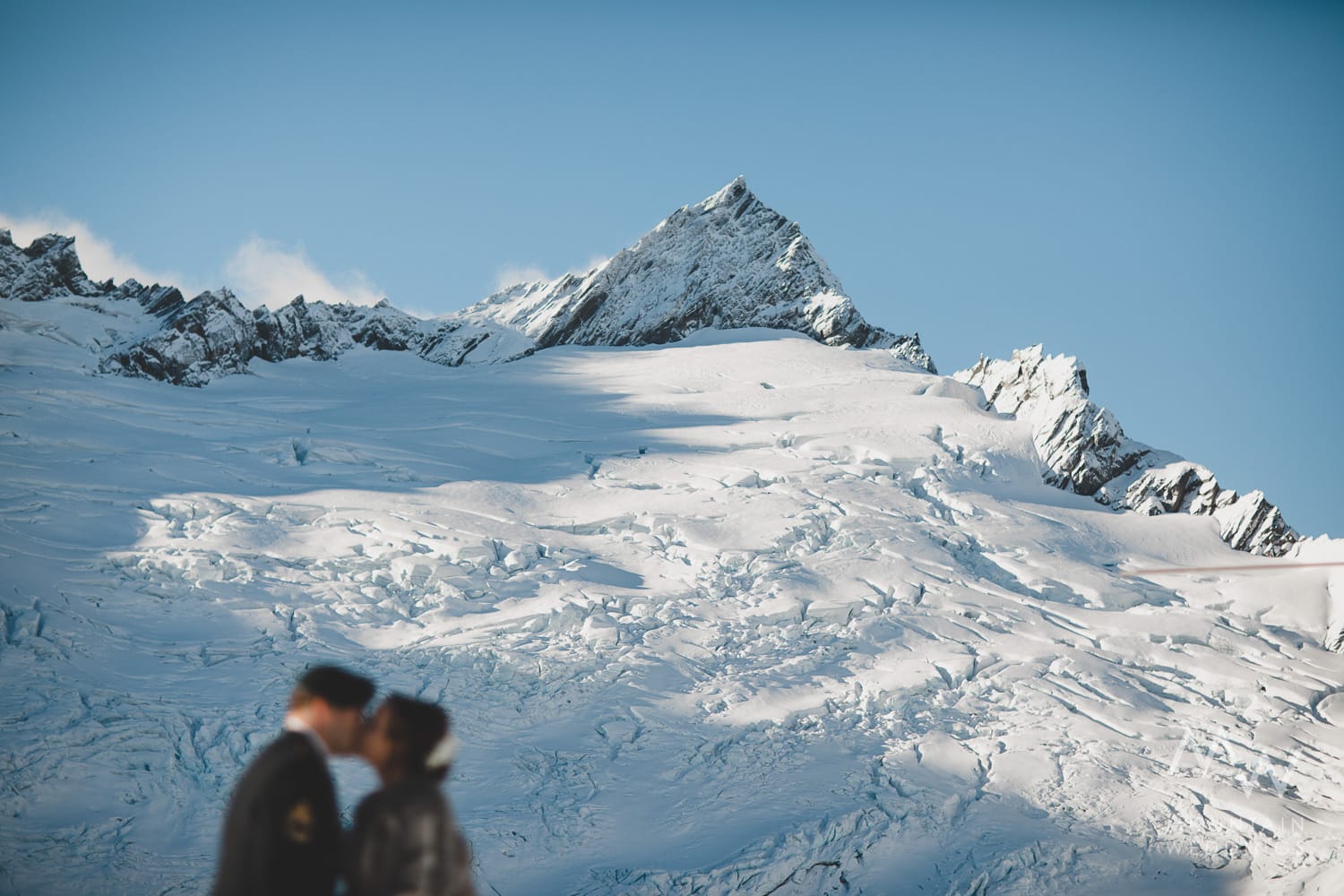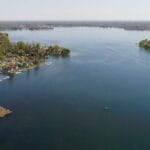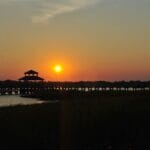Witness the Majesty of Tyndall Glacier
Imagine standing before a giant of ice, its surface shimmering like a thousand diamonds under the sun. That’s Tyndall Glacier, nestled high in the heart of Rocky Mountain National Park. Every year, folks drawn by its beauty and the thrill of adventure make their way to this icy giant, hiking through breathtaking landscapes to witness its powerful presence firsthand.
The journey to Tyndall Glacier is an experience in itself, beginning at the Bear Lake trailhead. As you start your hike, you’re greeted by a string of peaceful lakes, each offering a sneak peek of the glacier’s icy majesty in the distance. The higher you climb, the more dramatic the scenery becomes, with towering peaks scraping the sky and waterfalls cascading down rocky slopes.
For thrill-seekers and climbing enthusiasts, Tyndall Glacier offers slopes angled between 35 to 50 degrees, covered in ice and snow. Whether you’re a seasoned climber with ice picks and ropes, or a brave beginner ready for a challenge, Tyndall Glacier welcomes you.
Interestingly, there are actually three glaciers sharing the name Tyndall. One spills dramatically into the sea in Alaska, while another carves its way through the towering peaks of Chile’s Torres del Paine National Park. Each Tyndall Glacier has its own unique personality and charm, but they all share a common story—a story about the impact of climate change.
Tyndall Glacier, like many of its icy brethren around the world, is shrinking. Over the years, scientists have observed how its once mighty expanse has slowly receded, leaving behind bare rock where ice used to reign. It’s a stark visual reminder of how our planet’s climate is changing, and the urgent need to protect these natural wonders.
So, if you’re planning a trip to Tyndall Glacier, remember to pack your sense of adventure, your respect for nature, and your camera. And while you’re marveling at its beauty, take a moment to appreciate the glacier’s story. It’s a powerful reminder of the delicate balance of our planet and the role we all play in protecting it.
Hiking to Tyndall Glacier: A Complete Guide
Ready to experience the awe-inspiring Tyndall Glacier? This hike is more than just a walk in the park; it’s a journey through some of nature’s grandest landscapes, from towering peaks and mirror-like lakes to the majestic glacier itself.
Finding Your Path: Trail Options
Choosing your route is part of the adventure! Here’s the rundown on the most popular trails:
Emerald Lake Trail (The Crowd Favorite): This trail is a “greatest hits” tour of the area’s beauty, taking you past Nymph, Dream, and Emerald lakes, each more stunning than the last. You’ll end up at the foot of the mighty Tyndall Gorge, with the glacier looming above.
Flattop Mountain Trail (For the Adventurous Soul): This trail is for those who like their hikes with a side of “wow.” It takes you on a climb to the summit of Flattop Mountain, offering panoramic views of the entire park. Combine this trail with the Emerald Lake Trail for an unforgettable loop.
A Closer Look: Points of Interest
Nymph Lake: This charming lake is the first one you’ll meet on the Emerald Lake Trail. Don’t let its size fool you – it’s bursting with character, especially in the summer when its surface is dotted with colorful lily pads.
Dream Lake: This lake lives up to its name. With the towering Hallett Peak reflected perfectly in its still waters, it’s a view you’ll want to capture and remember.
Emerald Lake: Prepare to be dazzled! This lake is famous for its intense emerald green color, caused by glacial flour – finely ground rock particles suspended in the water.
Tyndall Gorge: Get ready for some serious drama! This glacial valley is a masterpiece of nature’s artistry, with towering cliffs, cascading waterfalls, and a raw, untamed beauty that will take your breath away.
Tyndall Glacier: And finally, the star of the show! While it’s true that the glacier has retreated significantly over the years due to climate change, it’s still a powerful sight to behold. Exploring the glacier itself requires experience, specialized gear, and careful planning.
Be Prepared: Gear and Safety
Venturing into the alpine world is an incredible experience, but it’s essential to be prepared. The mountains demand respect, and a little preparation goes a long way:
Must-Haves:
- Ice Axe: You’ll want a proper mountaineering ice axe for navigating any icy patches, especially later in the summer.
- Sturdy Hiking Boots: Make sure they’re well broken-in and provide good ankle support.
- Layers of Clothing: Mountain weather is unpredictable. Be prepared for sunshine, rain, wind, and everything in between.
- Water, Water, Water: Bring plenty of it! Dehydration is a real risk, especially at higher altitudes. Aim for at least 2 liters.
Good to Have:
- Crampons: As summer progresses and snow melts, trails can become icy. Crampons, which attach to your boots, provide extra traction.
- Helmet: Falling rocks are a hazard in mountainous terrain. A helmet can literally be a lifesaver.
- Sun Protection: The sun’s rays are more intense at higher elevations. Pack sunscreen, a hat, and sunglasses.
- Snacks: Hiking burns calories! Bring energy-boosting snacks to keep you fueled up.
- Navigation Tools: A map and compass are essential, even if you’re using trail maps. Phone batteries can die, and knowing how to navigate the old-fashioned way is a crucial safety skill.
- First-Aid Kit: Accidents happen. Be prepared with a basic first-aid kit.
- Bear Spray: It’s always a good idea to carry bear spray in bear country.
Tips from Seasoned Hikers:
- Weather Wisdom: Check the forecast before you go, and be prepared for sudden changes.
- Early Bird Gets the Worm: Start your hike early in the day to avoid afternoon thunderstorms, which are common in the mountains.
- Safety in Numbers: Hike with a buddy! It’s safer and more fun.
- Leave No Trace: Pack out everything you pack in, and be mindful of the impact you have on the environment.
A Changing Landscape: Witnessing Climate Change
As you stand before the majestic, yet shrinking, Tyndall Glacier, you’re witnessing a powerful testament to the reality of climate change. The glacier’s retreat is a stark visual reminder of the impact human activities have on our planet. While scientists continue to study the complexities of climate change, the retreat of glaciers like Tyndall serves as a clear signal that our planet is changing, and that we have a role to play in protecting its future.
A hike to Tyndall Glacier is more than just a physical journey; it’s a journey of discovery, awareness, and appreciation for the raw beauty and power of nature. So, pack your bags, lace up your boots, and get ready for an unforgettable adventure!
Witnessing Climate Change: The Retreat of Tyndall Glacier
Climate change is affecting our planet, and Tyndall Glacier is a perfect example of this in action. This incredible glacier, whether observed in the breathtaking Patagonia region or on the slopes of majestic Mount Kenya, shows us just how much our planet is warming. As the glacier slowly melts away, it reveals the bare earth beneath, painting a powerful picture of the changes happening around us.
The shrinking of Tyndall Glacier isn’t just about losing ice; it impacts the entire landscape and the delicate balance of life it supports. As the glacier retreats, it leaves behind a blank canvas. Plants start to take root in this newly exposed ground, and gradually, the soil changes. This new environment attracts different kinds of animals and plants, leading to a shift in the area’s biodiversity. It’s fascinating to witness this change, but it’s also a stark reminder of how fragile our ecosystems are.
The story of Tyndall Glacier is, unfortunately, not unique. All over the world, glaciers are shrinking at an alarming rate, transforming landscapes and posing a serious threat to plants, animals, and entire ecosystems. It’s a clear sign that we need to act fast to address climate change and protect our planet.
For decades, scientists have been carefully observing and studying Tyndall Glacier, meticulously tracking its retreat and gathering valuable data that helps us understand how climate change is unfolding and what we can do to protect our environment. These observations are like pieces of a puzzle, and by putting them together, we can get a clearer picture of what the future holds for our planet and how we can create a better tomorrow.
Exploring the Wonders Near Tyndall Glacier: Trails
Let’s explore the magnificent network of trails surrounding Tyndall Glacier.
One of the most popular routes, the Nymph, Dream, and Emerald Lakes Trail, is a gradual unveiling of breathtaking alpine scenery. Starting near Bear Lake, the trail gently climbs, revealing a sequence of stunning lakes. First up is Nymph Lake, often adorned with vibrant lily pads in the summer. Next, you’ll encounter Dream Lake, living up to its name with the majestic Hallett Peak mirrored in its glassy surface. Finally, Emerald Lake awaits, its rich green waters a testament to the glacial silt that gives it its distinctive hue. This trail is moderately challenging, covering about 3.5 miles roundtrip, making it a great option for most fitness levels.
Beyond the lakes, another must-explore route is the Tyndall Gorge Trail. This trail takes you deep into a glacial valley, surrounded by towering cliffs and cascading waterfalls. The gorge itself is a dramatic testament to the power of ice carving its way through the landscape over millennia. You might even spot some wildlife along the way, like marmots or pikas. The full Tyndall Gorge trek is a bit longer and more strenuous, around 5.4 miles roundtrip. It’s worth noting that certain sections of the gorge can be quite rocky and uneven, so sturdy hiking boots are definitely recommended.
For those seeking a true adventure, consider tackling the challenging climb up to the glacier itself. This requires experience in mountaineering and appropriate gear, as it involves navigating icy terrain and steep slopes. However, the rewards are immense, offering unparalleled views and a sense of accomplishment like no other. Remember, safety should always be your top priority. Check weather forecasts before you go, as conditions in the mountains can change rapidly.
If you’re not a seasoned climber, don’t worry! There are still plenty of ways to appreciate the majesty of Tyndall Glacier. Even from a distance, the glacier’s icy expanse is a truly awe-inspiring sight, a humbling reminder of the raw power and beauty of nature.
| Trail | Difficulty | Distance (roundtrip) | Estimated Time | Key Features |
|---|---|---|---|---|
| Nymph, Dream, Emerald Lakes | Moderate | ~3.5 miles | ~2-3 hours | Cascading waterfalls, alpine lakes, mountain views |
| Tyndall Gorge | Moderate/Strenuous | ~5.4 miles | ~3-4 hours | Glacial valley, waterfalls, wildlife |
| Tyndall Glacier Climb | Strenuous | Varies | Varies | Glacier trekking, challenging ascents |
The area around Tyndall Glacier is a protected wilderness area, so it’s crucial to practice Leave No Trace principles. Pack out everything you pack in, stay on marked trails to avoid disturbing fragile vegetation, and be respectful of the wildlife.
Research suggests that glaciers are incredibly sensitive to changes in climate. While scientists continue to study the complex dynamics of these icy giants, it’s probable that Tyndall Glacier, like many others around the world, may be changing over time. So, seizing the opportunity to witness its beauty now is all the more special.
Remember, exploring these trails isn’t just about ticking off a list; it’s about immersing yourself in nature, connecting with the landscape, and creating lasting memories.
Lakes: Where Ice Meets Water in Tyndall Glacier
The stunning lakes nestled within the icy grip of Tyndall Glacier are like liquid jewels, reflecting the towering peaks around them. These bodies of water, big and small, truly showcase the raw power of the glacier and the constant interplay between ice and water.
These high-altitude glacial lakes, sometimes called tarns, are a sight to behold. They’re a living testament to the glacier’s influence, shaped over time by the relentless forces of ice and meltwater.
Let’s take a closer look at a few of these remarkable glacier-carved lakes:
A Trio of Beauties: Nymph, Dream, and Emerald Lakes
Nymph, Dream, and Emerald Lakes are a string of sparkling gems draped along the glacier’s edge.
Nymph Lake, the first in this watery chain, offers a sense of tranquility, its calm waters dotted with lily pads.
Next comes Dream Lake, living up to its name. Framed by the imposing presence of Hallett Peak, the lake’s surface acts like a giant mirror, capturing the sky and clouds in its glassy reflection.
Finally, we reach Emerald Lake, tucked away at the foot of Tyndall Gorge. Here, the water takes on a truly magical hue – an otherworldly emerald green, thanks to the fine glacial silt suspended within it.
The Mysterious Transformation of Lake Haiyaha
Lake Haiyaha presents a different kind of beauty, a touch more mysterious. While it was once known for its crystal-clear waters, it has undergone a dramatic transformation. The lake now shimmers with a milky blue hue, a result of increased glacial melt. This phenomenon, while stunning, also offers a glimpse into how these environments are constantly changing. The glacial flour, as the fine silt is called, gives the lake a unique, almost ethereal appearance.
The Glacier’s Shaping Hand: How Tyndall Influences its Lakes
Tyndall Glacier isn’t just a backdrop; it’s a vital force shaping the very existence of these lakes. The glacier’s meltwater constantly feeds these aquatic wonders, sustaining their water levels. Moreover, the glacier itself has carved the landscape over millennia, creating the basins that hold these liquid jewels.
As our climate changes and the glacier continues to retreat, these lakes are likely to experience shifts in their size, shape, and even color. It’s a reminder that these beautiful environments are delicate and susceptible to the impacts of a warming world. Some scientists suggest that as the glacier recedes, new lakes may even form, while existing ones might shrink or disappear altogether. Researchers are actively studying these changes, trying to understand the long-term effects on the park’s ecosystem.
| Lake | Characteristics | Glacial Influence |
|---|---|---|
| Nymph Lake | Serene, lily pads, reflective surface | Fed by glacial meltwater |
| Dream Lake | Framed by Hallett Peak, sky reflections | Carved by glacial activity, fed by meltwater |
| Emerald Lake | Emerald hue due to glacial silt | Glacial silt gives unique color, fed by meltwater |
| Lake Haiyaha | Milky blue due to increased glacial melt | Transformation in color due to glacial meltwater input |
It’s important to remember that our understanding of these complex systems is constantly evolving. Ongoing research is crucial for unraveling the intricacies of glacial lakes and predicting how they might respond to future changes.
Tyndall Glacier and Peaks
Tyndall Glacier sits nestled among some serious mountain giants, creating a scene that’s both dramatic and delicate. Imagine a river of ice flowing down from Hallett Peak, glistening under the sun. It’s a breathtaking sight, a reminder of the raw power and artistry of the natural world. And it’s a place where you can really feel the impact of climate change.
The hike to Tyndall Glacier takes you through a constantly changing landscape. You’ll start among thick forests, the trail winding through trees and dappled sunlight. Then, as you climb higher, the trees thin out, giving way to meadows bursting with wildflowers. Crystal-clear lakes, reflecting the surrounding peaks, pop up along the way, offering moments of quiet reflection. The air gets crisper, cleaner, and with each step, you feel closer to the heart of the mountains.
Tyndall Glacier is a dynamic, ever-changing feature of the landscape. The surface is textured with intricate patterns, sculpted by wind, snow, and the slow, relentless creep of the ice.
Tyndall Glacier, like many glaciers worldwide, is shrinking. The evidence is there for all to see. If you compare photos of the glacier from years past, you’ll see a dramatic difference. The ice has retreated, leaving behind bare rock – a stark reminder of our changing climate.
A trip to Tyndall Glacier is more than just a hike; it’s a journey into the heart of a critical issue. It’s a chance to experience the raw beauty of the wilderness while confronting the reality of climate change.
Scientists are actively studying glaciers like Tyndall, trying to understand the complex factors influencing their retreat. Some research suggests a connection between rising global temperatures and glacial melt. While the exact mechanisms are still being explored, the overall trend is clear. Glaciers are shrinking, and this has significant implications for water resources, ecosystems, and even sea levels.
| Potential Impact of Glacier Retreat | Description |
|---|---|
| Water Resources | Reduced water availability for downstream communities and ecosystems |
| Ecosystem Disruption | Changes in habitat, impacting plant and animal life |
| Sea Level Rise | Melting glaciers contribute to rising sea levels globally |
It’s important to remember that scientific understanding is always evolving. New research constantly adds to our knowledge, and sometimes even changes our understanding of how things work. While the current evidence strongly suggests that human activity is playing a role in climate change, ongoing research continues to refine our understanding of these complex processes.
Visiting Tyndall Glacier offers a unique opportunity to connect with these issues on a personal level. It’s a chance to see the beauty, understand the challenges, and contemplate our role in protecting these precious landscapes for future generations. While the future of Tyndall Glacier and other glaciers around the world remains uncertain, one thing is clear: understanding and addressing climate change is one of the most important challenges of our time.
John Tyndall’s Legacy: From Science to the Colorado Rockies
Tyndall Glacier, tucked away in Rocky Mountain National Park, isn’t just a pretty sight. It’s a living monument to a man who dedicated his life to unraveling the mysteries of the natural world: John Tyndall.
Imagine hiking through this rugged, awe-inspiring landscape, knowing you’re walking in the footsteps of a scientific pioneer. The journey itself is an adventure, starting at the Bear Lake Trailhead and taking you through vibrant forests and past glistening streams.
As you approach the glacier itself, the sheer size of this massive river of ice, carved through the mountains over centuries, is truly impactful.
Tyndall wasn’t just a lab coat scientist; he was an adventurer, a mountaineer drawn to the icy heights of the Alps. It was during those climbs that he began to understand the vital role glaciers play, how sensitive they are, and what their health can tell us about the Earth’s overall well-being. He recognized their importance long before many others did.
Standing before Tyndall Glacier today, you’re not just looking at a stunning natural wonder; you’re seeing the impact of climate change firsthand. The glacier’s once-smooth surface is now fractured with deep crevasses, and its edges are shrinking. It’s a powerful and sobering experience, one that connects you directly to the urgent need for climate action. Tyndall’s pioneering work on the greenhouse effect, which explains how gases in our atmosphere trap heat, explains why we should expect this kind of thing to happen with increasing global warming.
Our understanding of glaciers and climate change is still evolving. Scientists continue to study these icy giants, learning more about their complex relationship with the environment. They’re using cutting-edge technology to monitor their movements, measure their melting rates, and predict their future. Some researchers are even investigating ways to potentially slow down glacial melt or mitigate its impact. It’s an area of ongoing research, and every discovery brings us closer to understanding the full story of our planet.
A visit to Tyndall Glacier isn’t just a hike; it’s a journey through time, a connection to a scientific pioneer, and a stark reminder of the challenges we face. It’s a chance to reflect on the legacy of John Tyndall, whose curiosity and passion for knowledge continue to inspire us today. And it’s a call to action, urging us to protect these fragile wonders for generations to come.
Consider this:
| Feature | Significance |
|---|---|
| Location | Rocky Mountain National Park, Colorado, USA |
| Accessibility | Reachable via the Bear Lake Trailhead, offering a challenging but rewarding hike suitable for experienced hikers. |
| Scientific Value | Serves as a living laboratory for studying glacial dynamics and the impact of climate change. |
| Historical Value | Named after John Tyndall, a pioneering physicist and mountaineer who contributed significantly to our understanding of glaciers and the greenhouse effect. |
It’s a trip that’s likely to stay with you long after you’ve left the mountains, motivating you to learn more about the environment and consider your own role in preserving our planet.
Capturing Tyndall Glacier: Photography Tips and Best Spots
This icy wonderland, with its turquoise lakes and dramatic peaks, offers endless photographic opportunities.
Prime Locations for Glacier Gazing (and Photographing!)
Right at the Foot of the Glacier: From this perspective, you can truly appreciate the scale of the ice formations and capture the intricate textures of the ice. Try experimenting with different angles and perspectives. Look for interesting foreground elements like rocks or streams to add depth to your images.
Flattop Mountain – A Bird’s-Eye View: For a panoramic vista that will take your breath away, hike up to Flattop Mountain. From this elevated position, you can capture the glacier in its entirety. This is a great spot to showcase the vastness of the landscape. Try using a panoramic stitching technique to capture an even wider view.
Hallett Peak – The Adventurer’s Shot: If you’re up for a bit more of a challenge, the hike to Hallett Peak is incredibly rewarding. This vantage point provides unique, dramatic perspectives of Tyndall Glacier.
Tyndall Gorge – Hidden Gems: Waterfalls cascade down sheer rock walls, wildflowers add splashes of color, and the glacier looms in the background. This location offers endless possibilities for capturing the glacier’s beauty from a different angle. Look for intimate scenes and details within the gorge.
Tips and Tricks for Stunning Glacier Shots
Gear Up: A wide-angle lens (something like 16-35mm), a polarizing filter, and a tripod are highly recommended.
Light it Right: The “golden hour” (sunrise and sunset) provides the most magical light for glacier photography. The warm, soft light enhances the blues and whites of the ice and creates a beautiful atmosphere.
Compose with Care: Think about how you want to lead the viewer’s eye through your image. Use leading lines, like hiking trails or streams, to draw attention to the glacier. The rule of thirds is a classic composition technique that can create a balanced and visually appealing image.
Safety First: Remember, safety should always be your top priority. Wear appropriate clothing and footwear for the conditions, bring plenty of water, and be aware of your surroundings.
| Feature | Description | Benefit |
|---|---|---|
| Wide-angle lens (16-35mm) | Captures a broad field of view | Ideal for grand landscapes and showcasing the glacier’s size |
| Polarizing filter | Reduces glare from ice and water | Enhances color saturation and clarity |
| Tripod | Stabilizes the camera | Prevents blurry images, especially in low light or during long exposures |
| Golden hour lighting | Soft, warm light during sunrise and sunset | Creates a magical atmosphere and enhances colors |
| Rule of thirds | Composition guideline | Creates balanced and visually pleasing images |
Taking Your Glacier Photography to the Next Level
Time-Lapse Magic: Capture the dynamic nature of the glacier by creating a time-lapse video.
Details, Details: Zoom in on the intricate textures of the ice, the patterns of meltwater streams, or the unique rock formations surrounding the glacier.
Seasonal Variations: Tyndall Glacier transforms throughout the year. Summer brings lush greenery and wildflowers, while winter blankets the landscape in snow and ice.
Your Unique Perspective: Don’t be afraid to get creative and personalize your shots. Incorporate elements of your journey, like your hiking boots or footprints in the snow.
Some photographers suggest scouting locations beforehand, either virtually or in person, to get a sense of the terrain and plan your shots. There’s always ongoing research regarding the impact of climate change on glaciers, and Tyndall is no exception. The glacier’s appearance may evolve over time, adding another layer of complexity and interest to photographing this incredible natural wonder. Remember, photography is about exploration and discovery. Don’t be afraid to experiment, try new techniques, and most importantly, have fun capturing the breathtaking beauty of Tyndall Glacier.
Key Points:
- Tyndall Glacier is a majestic ice giant: Located in Rocky Mountain National Park, Tyndall Glacier is a must-see for any visitor.
- The hike to the glacier is challenging but rewarding: Offering stunning views of lakes and rugged peaks, the hike to Tyndall Glacier is an experience in itself.
- Tyndall Glacier is a popular destination for climbers: With slopes ranging from 35 to 50 degrees, the glacier provides a challenge for climbers of all skill levels.
- There are three glaciers named Tyndall around the world: Including one in Alaska and one in Chile, each Tyndall Glacier offers a unique perspective on the impact of climate change.
- All Tyndall Glaciers are experiencing shrinkage due to climate change: The retreat of Tyndall Glacier serves as a reminder of the urgent need to protect natural wonders.
- Visitors should appreciate the glacier’s beauty while recognizing its role in highlighting climate change: As you enjoy the beauty of Tyndall Glacier, take a moment to reflect on its significance as a symbol of our changing climate.
















1 thought on “Hiking to Tyndall Glacier: A Journey Through Beauty and Climate Change”
Comments are closed.